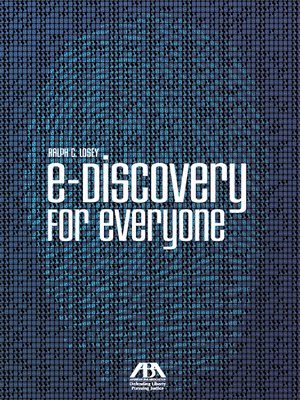
Sign up to save your library
With an OverDrive account, you can save your favorite libraries for at-a-glance information about availability. Find out more about OverDrive accounts.
Find this title in Libby, the library reading app by OverDrive.



Search for a digital library with this title
Title found at these libraries:
| Library Name | Distance |
|---|---|
| Loading... |
In the short span of a decade and a half, the practice of discovery of writings, recordings, photographs, and other non-testimonial evidence in civil cases in state and federal courts has transformed from one that was based almost entirely on the manual retrieval, review and production of tangible documents by lawyers and paralegals to one that is almost entirely dependent on accessing, searching, reviewing and producing digital or computer-generated information. The "digital explosion" has required fundamental revisions to the Federal Rules of Civil Procedure, first in 2006, and most recently in 2015, and even more fundamental changes in how lawyers and judges must think about discovery in civil cases. Along the way, many participants in the process of civil litigation felt as though they were called on to engage in a battle of wits for which they were unarmed—lacking the technical know-how to survive. While the newest members of the legal profession typically have greater knowledge (and less fear) regarding what is needed to engage in what has come to be known as "e-Discovery," there are many lawyers and judges of a certain age who do not, and who look at the process with concern, if not fear and loathing.
Part of the problem lies with not knowing where to begin to develop the knowledge and experience needed to survive in the daunting new world of e-Discovery. Where do you turn to learn what the issues are, let alone how to resolve them? Most lawyers are not computer scientists, statisticians, or semanticists, and getting the training to be competent in using computer assisted review (also called technology assisted review, or "TAR") to more effectively and inexpensively search large digital information sets seems beyond our grasp.
Enter Ralph Losey and the ABA with e-Discovery for Everyone, an introduction to e-Discovery that avoids over-technicality, without being substantively superficial, and manages to be interesting and at times even amusing. Ralph has been writing his e-Discovery Team blog since 2006, and e-Discovery for Everyone assembles many of his most helpful and recent blog posts in a collection that will be of value to newcomers to e-Discovery as well as seasoned practitioners. The book is written in a conversational style, and is divided into short chapters easily read in a relatively short sitting. Sprinkled throughout are very helpful references to cases, secondary sources and other materials that give the book depth beyond its relative brevity. A quick look at the table of contents shows an impressive inventory of the most important e-Discovery topics of the day: new methods of search and review, a discussion of the 2015 amendments to the Federal Rules of Civil Procedure, practical advice on litigation holds, how to evaluate the reasonableness of e-Discovery vendor bills, the advantages of transparency in selecting how to design a search for digital information, why cooperation during the e-Discovery process is essential to success, ethical issues associated with e-Discovery, and how to confront and control e-Discovery abuses.







